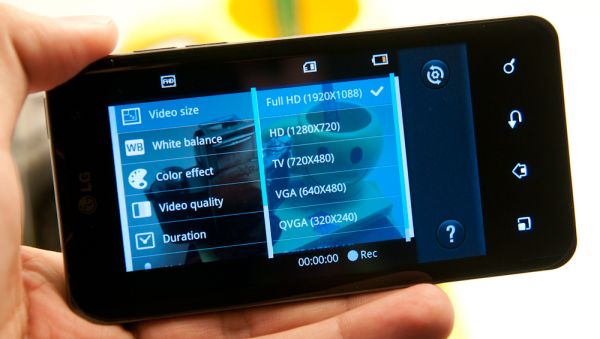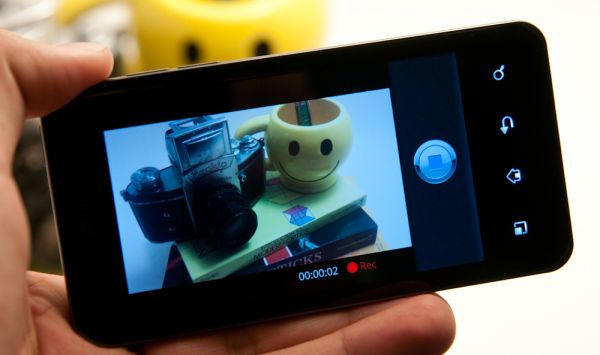LG Optimus 2X & NVIDIA Tegra 2 Review: The First Dual-Core Smartphone
by Brian Klug & Anand Lal Shimpi on February 7, 2011 3:53 AM EST- Posted in
- Smartphones
- Tegra 2
- LG
- Optimus 2X
- Mobile
- NVIDIA
Video Capture
The other big part of the 2X is that it’s the first smartphone to do H.264 1080P video capture. We took the 2X out to our usual test site and recorded video on the 2X at every quality setting at 1080p, and at maximum quality at 720P and VGA resolutions, and one final video with the front facing camera. I looked at the videos and then had Ganesh, our resident media center and video expert, as well as Anand take a look at the same original videos and compare to our other devices. It’s hard to argue that the iPhone 4 and Nokia N8 aren’t the devices to beat, both of them cranking out impressively sharp 720P video. We’ve done the usual thing and uploaded all the test videos to YouTube in addition to making a big zip for comparison in their original glory—links are in the table below.
Before we get to our comparison, a little background. First off, the 2X records 1920x1088 video in H.264 Baseline profile at an average of around 12 Mbps, audio is 1 channel AAC at 64 Kbps. The specifications for the 2x say 1080p24, in practice I’ve seen some framerate variability between 24 and 30 depending on lighting conditions. These videos are close to but not exactly 30 FPS, two videos I shot with the 2X at CES are clearly 24 FPS. Why the extra 8 pixels of vertical resolution, you might be wondering? The reason is simple—1088 is an even factor of 16, and macroblocks are 16x16 pixels.
| LG Optimus 2X Video Capture Samples | |||||
| Rear Facing 8 MP Camera |
1080P—SuperFine 1080P—Fine 1080P—Normal 720P—SuperFine 480P—SuperFine |
||||
| Front Facing 1.3 MP Camera | VGA—SuperFine | ||||
| LG Optimus 2X vs iPhone 4 at 720P | Mashup—YouTube, MP4 (zip), iPhone 720P (zip) | ||||
| LG Optimus 2X Original Videos | Original Videos (153.6 MB zip) | ||||
So how does 1080p24 video shot on the 2X compare to the iPhone 4 and Nokia N8? Unfortunately, not all that well. At 1080P there’s noticeable softness and loss of high spatial frequency detail. At about the 3 second mark in the first video I took (1080p at Super Fine) there’s also some noticeable glare from light flaring off of the glass surface between the camera’s last vertex and the plastic battery door. It’s that kind of stuff that’s a bit frustrating to still see going on with smartphones. The video has noticeable macro-blocking artifacts in the dark regions as well, which is disappointing. Though the Tegra 2 ISP is competent as shown by still image quality, clearly the video encode engine needs a bit more work. SuperFine as we already mentioned corresponds to around 12 Mbps, Fine corresponds to 8.5 Mbps, Normal quality seems to hover around 6 Mbps. You can fit a little over an hour of SuperFine quality 1080P video on the user-accessible 6 GB partition of the 2X’s 8 GB internal storage.
The obvious comparison really is at 720P, where we can directly compare the 2X’s video quality to the N8 and iPhone 4. I don’t have the N8 anymore, our comparison video is still what’s in bench. I do still have an iPhone 4, and captured a video taken at the exact same time as the 2X held carefully above the other phone. You can view both for yourself or compare with a mashup I put together showing both at the same time. The video I made showing both has a bit of downscaling and is at 30 FPS (so the 2X video occasionally looks like it’s dropping frames when it really isn’t), but still illustrates the differences.
Watching both at the same time, it’s readily apparent that the iPhone 4 does a noticeably better job with high frequency spatial detail, where the 2X seems to have softening. The 2X does do a better job with the dark areas of the intersection when panning back, but there’s still macroblocking visible. It’s obvious that there’s a combination of encoder and optics holding the 2X back from having dramatically higher quality video.












75 Comments
View All Comments
matt b - Tuesday, February 8, 2011 - link
Just curious because I've heard rumors that HP will use the Qualcomm chipset and I've also heard rumors that they will stick with Ti for their new tablets/phones. I just wondered if you know for sure since I know that you met with folks at CES. I hope that we all find out tomorrow at the HP event.Great review.
TareX - Wednesday, February 9, 2011 - link
I'd like to see Tegra 2 on the Xoom compared to Tegra 2 on the Optimus 2X.Why? Well, simply put, the only Android version that seems to be optimized for dual-core is Honeycomb.
Dark Legion - Wednesday, February 9, 2011 - link
Why is there no Incredible on 2.2? I could understand if you had both 2.1 and 2.2, like the Evo, but as it is now does not show the full/current performance.Morke - Thursday, February 10, 2011 - link
"It’s a strange dichotomy that LG sets up with this launcher scheme that divides “downloaded” apps from “system applications,” one that’s made on no other Android device I’ve ever seen but the Optimus One. The end result is that most of the stuff I want (you know, since I just installed it) is at the very last page or very bottom of the list, resulting in guaranteed scrolling every single time. If you’re a power user, just replace the launcher with something else entirely."You are not right there.
First you can create additonal categories (aside from system applications and downloads) and move applications between them.
Secondly you can rearrange the ordering of the applications inside a category (allowing you to have those on top which you access most frequently). You can also delete applications right away in this edit mode.
There is a youtube video demonstrating this:
http://www.youtube.com/watch?v=Dvvtl6pSNp8
See time index starting with 4:21.
Maybe you should correct your review on this?
Morke - Thursday, February 10, 2011 - link
The correct youtube URL demonstrating application launcher management is actuallyhttp://www.youtube.com/watch?v=lDo-1-jwLko&fea...
brj_texas - Thursday, February 10, 2011 - link
Anand,A question on the statement in the benchmarking section, "the SunSpider benchmark isn't explicitly multithreaded, although some of the tests within the benchmark will take advantage of more than one core. "
My understanding was that all of the tests within sunspider are single-threaded, but a dual-core processor can run the javascript engine (and the sunspider tests) in a separate thread from the main browser thread when you call sunspider from a browser window.
Can you clarify which tests support multi-threading in sunspider if that is in fact what you meant?
On the topic of multi-threading, we've used moonbat, a multi-core variant of sunspider, to explicitly test multi-core performance with javascript code. I wonder if you have any other benchmarks under investigation that measure multi-core performance?
Thanks
-Brian
worldbfree4me - Saturday, February 12, 2011 - link
Thanks for another thorough and in-depth analysis. But I have a question to ask,Should we upgrade (break our 2 year contract agreement for this phone) or ride out our contract?
We trust and value your our opinion. Tom’s hardware does a GPU hierarchy chart every few months, can you do a phone hierarchy in the future?
lashton - Sunday, February 13, 2011 - link
They have a really good idea and lead the market but it falls short because its not quite righttnepres - Tuesday, April 5, 2011 - link
I now own a optimus 2x. The first was dead on arrival, but this one is perfect. The LG software is innovative and pleasing to the eye. In various places they made real improvements to the UI that are just brilliant,ie. the ability to sort and categorize apps. At times the UI is not as fast as you would expect, especially when adding apps/widgets to one of the 7 pages. It seems LG generates a list of widgets for you, so you can see what apps support this mode, and that takes about a second. As I recall, on HTC devices you are just presented with a list of apps and u have to try and see if you can widget it.The LG keybord has a brilliant feature, you tab the side of the phone to move the cursor. Sadly in other respects the keyboard is lacking, ie. when you long-pres you do not get the alternates you might wish, such as numbers.
The batterytime is superb, using the UI consumes much less power than on my desire.
Copy/paste in the browser does not activate via long-pres, you have to hit menu button, but on the plus side its easier to use than what HTC made.
During 2 days of very intensive use i have had 1 app (partially) crash and that was the marketplace. No other issues so far, its my verdict that the unstability issues are overrated.
No problems with wifi using stock ISP (TDC) supplied router. (sagemcom)
To engadget: How on earth (!!?!!?) can you state there is no use for dualcore. When browsing one loads flash the other the rest. Its so fast you cant believe it. Try loading www.ufc.com on a non dualcore phone and you get my drift.
I do not hesitate to give the optimus 2x my warm recommendations.
VERDICT: 9/10 (missing 4g)
Sannat - Thursday, May 12, 2011 - link
gsmarena sound benchmark for optimus 2x isnt great...could it be a s/w issue...??